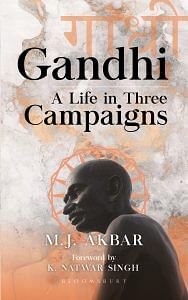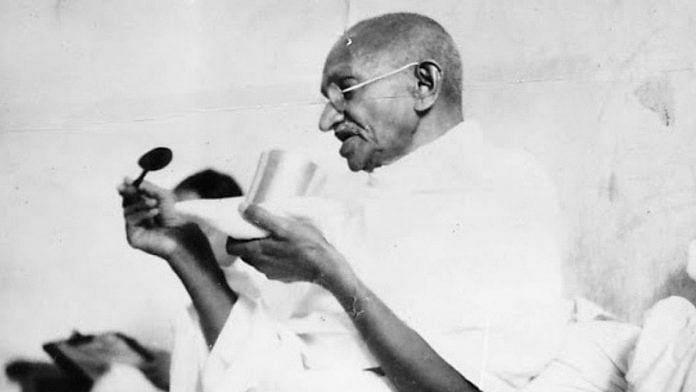Gandhi transformed khadi from the compulsion of poverty to the dress code of nationalism. He practised before he preached. Every inmate of his Satyagraha Ashram at Sabarmati, set up on the banks of the river in Ahmedabad in May 1915, was asked to wear self-made handspun. It was a small beginning. In November 1917, Gandhi met a ‘remarkable lady’, Gangabehn Majmudar, while presiding over the Broach Educational Conference. She was a widow without much education, but ‘in courage and common sense she easily surpassed the general run of our educated women’. She was quite at ease on horseback and moved freely among the ‘suppressed classes’.
Gangabehn found the way forward in Baroda at a place called Vijapur. ‘Quite a number of people there had spinning wheels in their homes, but had long consigned them to the lofts as useless lumber.’ They promised to resume spinning if assured that someone would buy their product. Yarn began to pour into Gandhi’s ashram. The inmates, using slivers gifted by Umar Sobhani, Gandhi’s mill-owner friend, produced their first piece of coarse khadi at a cost of seventeen annas per yard. Gandhi could not use this for his own dhoti as it was only thirty inches wide, and he needed a width of forty-five inches. He sent Gangabehn an ultimatum: if the right size was not spun, he would wear the short cloth baring even more of his body. Horrified, she sent him what he needed.
Gandhi had begun to weave what he described as the thread of destiny. For him, the fate of India lay in the welfare of ‘the semi-starved semi-employed women of India’.
Both Gandhi and the Indian Left wanted to eliminate India’s poverty. The significant difference was that while the Left believed that this could only be achieved after driving out the British, through the power of a national government, Gandhi refused to wait. He sought to alleviate the economic havoc perpetrated by British rule even while he aroused millions to challenge imperialism. He offered practical solutions rather than theory; he created both the product, yarn from a spinning wheel, and its market, the Indian consumer, through public mobilisation to supplement the income of the deprived. Liberty and God, he said, were meaningless words for the starving; their messiah would be the one who brought them a crust of bread.
The Mahatma’s activism was infectious. By the middle of 1920, Gandhi would write, ‘Slowly but surely the music of perhaps the most ancient machine of India is once more permeating society’. Gandhi, never shy of claiming a personal link with the Almighty, always maintained that the charkha revolution was not his invention. God had whispered into his ear: ‘If you want to work through non-violence, you have to proceed with
small things, not big’.
Gandhi’s approach to social change was deeply rooted in the idea of innovation through traditional practices, emphasizing the importance of local resources and community involvement.
At the magnetic heart of Gandhi’s philosophy was a unique form of mass regeneration, satyagraha, which can be roughly translated as ‘truth-force’. As with spinning, the ‘principle … came into being before that name was invented. Indeed when it was born, I myself could not say what it was’. He knew it was not passive resistance, a weapon of the weak with its implications of submission, and that it was driven by love, not hatred. Gandhi offered a prize to any reader of Indian Opinion who sent the best suggestion for a term that matched his innovative concept. Maganlal Gandhi, a young relative who had joined him in South Africa, suggested ‘sadagraha’. Gandhi altered this to satyagraha.
Even though Gandhi was clear when writing Hind Swaraj that his life’s work would be the liberation of India, he remained a loyal citizen of the empire during its great war against Germany between 1914 and 1918, just as his reservations about anti-Indian discrimination had not prevented him from helping the South African government against the Boers or the Zulus. Upon reaching Bombay in January 1915, he called upon the governor, Lord Willingdon, who made a request: ‘I ask one thing of you. I would like you to come and see me whenever you propose to take any steps concerning Government.’ Gandhi made that commitment. Willingdon thanked him and replied that his door would always be open. Through the tumult of his life, he kept his word.
In the hot summer of 1918, Gandhi nearly lost his life while trying to recruit soldiers in Gujarat for the British Army. He was shocked by the sullen reaction; it was evident that Indians hated the government. Pointedly, they wondered how a votary of ahimsa could ask them to take up arms. No one would lend him a cart or offer food, although his diet then was merely groundnut butter and lemons, as Gandhi decided to ‘trudge’ up to twenty miles
a day. The physical strain was compounded by an attack of dysentery caused by butter.
There were personal reasons for depression. He was estranged from his eldest son, Harilal, whose three-year-old son Shantilal and wife Gulab died in October 1918 within a week of each other. Gandhi broke down when he heard the news and tried to mend his relationship with Harilal by writing a letter a day. Harilal remained distant. But Gandhi was overjoyed when Harilal’s four other children came to stay with him in the ashram. On 23 February 1919, he wrote ‘To The Most Worthy Firm of Satyagrahis’, a jocular term used for Harilal and his friends, about his compassionate verdict on grandson Rasiklal’s offence, which was hitting an innocent dog: ‘As I write this, Kantilal is holding the inkstand. He and Ramibehn read the letter as I proceed and correct me. The accused, too, is here, meekly standing by the bed. Manubai interrupts now and then to give us the benefit of her laughter. And now she has started crying, wanting to climb up the bed. The scene reminds me of your childhood, of that of Jadibehn and others.’ He added, ‘Though I am confined to bed, you will see from the foregoing that my health can pass as good. Satyagraha is in the air here.’
 This excerpt from Gandhi: A Life in Three Campaigns by MJ Akbar has been published with permission from Bloomsbury India.
This excerpt from Gandhi: A Life in Three Campaigns by MJ Akbar has been published with permission from Bloomsbury India.






